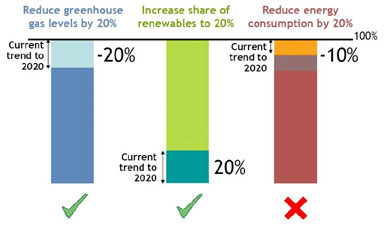Although the final numbers aren’t in, the European Union says it met its 2020 climate target last year – six years early. Nice!
EU’s 20-20-20 plan, set in 2008: by 2020, cut emissions 20% below 1990 levels; get 20% of all energy from renewables; increase energy efficiency 20%.
After emissions declined another 4.9% last year (GDP grew 1.3%), the EU met its carbon target, says the European Commission, and is on track to reach 20% renewables by 2020 (from about 15% now).
Impressively, the EU’s energy use is back to 1990 levels, despite a 6% population increase and 45% economic growth since then. Efficiency in buildings, manufacturing, fuel economy in vehicles are all playing important roles.

credit: Geospatial Blog
The EU recently announced binding targets for 2030: cut emissions 40% below 1990 levels, 27% of all energy from renewables, and increase efficiency 30%.
UK, Germany Lead on Emissions Cuts
In 2014, the UK cut emissions 9.2%, and Germany saw is first drop in three years – of 4.3%, according to its Environment Agency. Both countries’ emissions are 28% below 1990 levels, and renewables account for 19.2% of electricity in the UK and 27.8% in Germany.
Germany’s target is double the EU’s, shooting for 40% emission cuts by 2020. Agriculture and transportation are the two sectors where emissions are still rising and last year, an efficiency plan passed, creating incentives to bring them down.
Solar installations in Germany sunk to 2 gigawatts in 2014, down from 7.5 GW in 2012, as more cuts to the feed-in law took effect. With the cost of solar reaching parity with fossil fuels, people who install solar no longer benefit from 20 years of guaranteed payments, and feed-in tariffs pay about $0.20 per kilowatt hour, down from the $0.90 in 2009.
"We don’t have subsidy free markets anywhere in the EU so why is the commission ruling against feed-in-tariffs for renewables in Germany while granting them in the UK for nuclear?" Milan Nitzschke, vice president of SolarWorld, asked The Guardian. "The thinking is completely wrong. It is creating a less efficient system that only benefits major players with huge windfall effects."
This is what critics of the feed-in law cutbacks say. The system has been changed so much, it now only benefits big corporations, like those involved in offshore wind.
While the press has led the world to believe feed-in laws had to be cut because over-generous subsidies caused electricity costs to spike, that isn’t the case, says Craig Morris at Renewables International. "Rather, Germany simply built a lot of PV when it was expensive. Now that PV is cheaper, there is little risk of it (or onshore wind) raising the price of electricity much. But a lot of offshore wind could" because those costs are still very high.
"More than potentially slowing down the energy transition, the changes are likely to hand over ownership from the citizens and cooperatives that have driven the transition over the past few decades to the corporations that have worked to slow things down," he says.
Read our article, Germany’s Contradictions: Renewables Leader Turns to Coal, Fracking.
Learn more about Germany’s current feed-in law:
